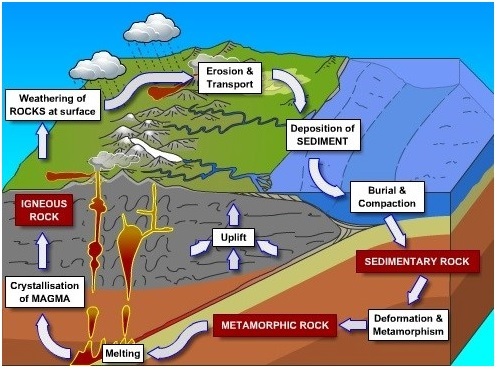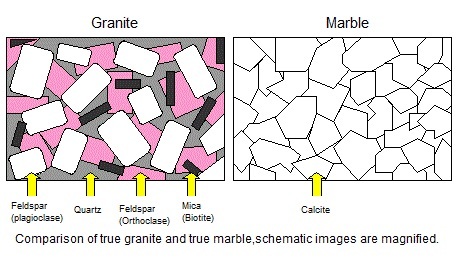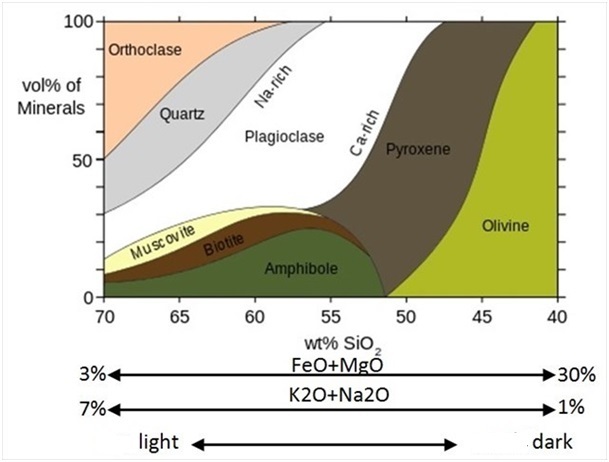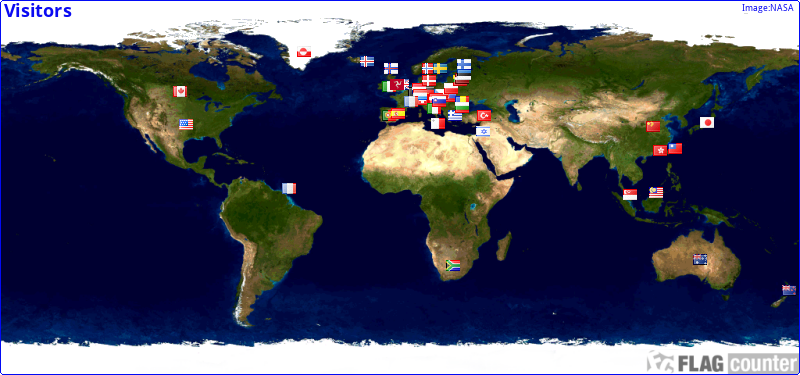
The learning point of this earthcache is to get to know the granite stone better.
The coordinates lead you to the front of the Hallgrìmskirkja, and the well known explorer Leifur Eirìksson statue. The colored stones at this monument are made of the granite rock.
Rocks found on the Earth's surface actually come from inside the Earth - so they tell us a lot about the Earth's interior. They are classified into three main groups: igneous rocks, sedimentary rocks and metamorphic rocks.

Igneous rock
Igneous rocks are formed by magma from the molten interior of the Earth. When magma erupts it cools to form volcanic landforms. If magma cools inside the Earth it forms intrusive rock, which may later be exposed by erosion and weathering.
Metamorphic rock
Metamorphic rocks have been subjected to tremendous heat and/or pressure, causing them to change into another type of rock. They are usually resistant to weathering and erosion and are therefore very hard-wearing.
Sedimentary rock
A river carries, or transports, pieces of broken rock as it flows along. When the river reaches a lake or the sea, its load of transported rocks settles to the bottom. We say that the rocks are deposited. The deposited rocks build up in layers, called sediments. This process is called sedimentation.
Granite
Granite is a common type of felsic intrusive igneous rock with crystal grains (medium to coarse grained) large enough to be visible with the unaided eye. It is a light-colored rock that can be predominantly white, reddish/pink, or gray in color, depending on its mineralogy. It comprises some of the oldest known rocks on Earth, and is the most abundant basement rock underlying the relatively thin sedimentary rock cover of the continents. Granite is produced in volcanic arcs, and more commonly in mountain building resulting from the collision of two continental masses. It forms from the slow crystallization of magma below Earth's surface. Granite is composed mainly of ***quartz and feldspar (*Plagioclase and **Orthoclase) with minor amounts of ****mica, amphiboles, and other minerals.
The earliest continental masses were products of the accumulation of volcanic arcs, and this is why granite lies in the cores of all of the continents. Granite is the plutonic equivalent of rhyolite and belongs to the group of pluton. Pluton is a body of intrusive igneous rock that is crystallized from magma with slowly cooling below the surface of the Earth.
The minerals are crystallized (made / occurs) from magma in deep and extrusives ekstrusive. The size of the crystals tells us where and how far down into the crust they were made and formed. Easy said and explained, the larger the crystals are, the longer they have been forming, and the deeper into the crust they origin from.
*Plagioclase is the name of a group of feldspar minerals that form a solid solution series ranging from pure albite, Na(AlSi3O8), to pure anorthite, Ca(Al2Si2O8).
**Orthoclase is a feldspar mineral with a chemical composition of KAlSi3O8. It is one of the most abundant rock-forming minerals of the continental crust. Orthoclase is most widely known as the pink feldspar found in many granite types.
***Quartz is a chemical compound consisting of one part silicon and two parts oxygen. It is silicon dioxide (SiO2). It is the most abundant mineral found at Earth's surface.
****Mica (Biotite) is a name used for a large group of black mica minerals that are commonly found in igneous and metamorphic rocks. Biotite is a rock-forming mineral found in a wide range of crystalline igneous rocks such as granite, diorite, gabbro, peridotite, and pegmatite.


To log this cache.
To get to log this cache you will have to visit and answer the questions which are related to the coordinates given the earthcache.
When answers are collected, send them to CO for verification.
You can log immediately after answers are sent CO. If there are any questions about your answers CO will contact you.
Logs without answers to CO or with pending questions from CO will be deleted without any further notice.
Please do not include pictures in your log that may answer the questions.
Questions
1. Answer the questions under by visiting the coordinates, and study the backside of the monument with the inscription.
A. Have a look at the feldspar and quartz crystals here in the stone at gz. A-1) What size are they in mm? A-2) And as explained above in the text, what does this tell you about how deep down in the crust it origin from? (the connection between deep and time the rock has used to cool down after it was melted and then crystallized.)
B. What are the mineral mixture made up by that you can see in the stone? (looking for the 3 main sorts). And how many % would you say each of them represent in the stone?
C. Describe the front side and backside of the monument, are they any different from each other?
2. (It’s voluntary to post a photo in your online log of your visit)
Without revealing any answers!
